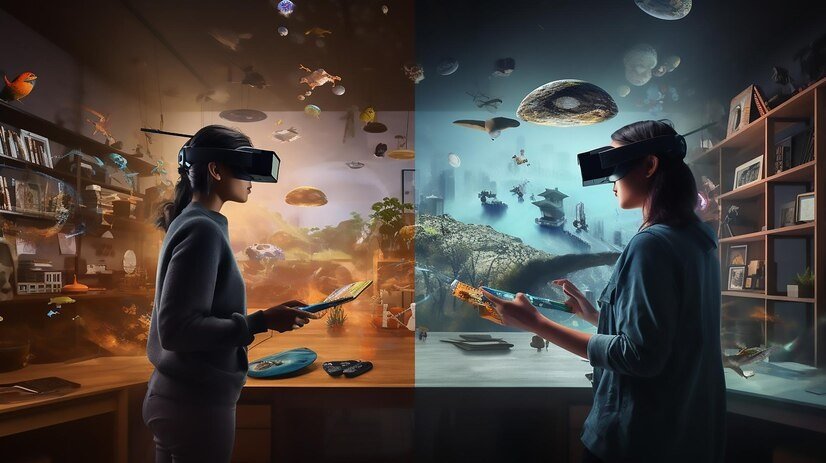Virtual Reality vs. Augmented Reality: Which Technology Will Dominate?

In recent years, Virtual Reality (VR) and Augmented Reality (AR) have emerged as two of the most exciting and transformative technologies. While both technologies aim to alter our perception of the world, they do so in fundamentally different ways. VR immerses users in a completely digital environment, disconnecting them from the physical world, whereas AR overlays digital elements onto the real world, enhancing rather than replacing reality. As these technologies continue to develop and integrate into various industries, a key question arises: which technology will dominate the future? This article explores the strengths, challenges, and potential of both VR and AR, examining their applications across industries and forecasting their roles in the future.
Understanding Virtual Reality (VR)
What is Virtual Reality?
Virtual Reality is a technology that creates a simulated environment, allowing users to immerse themselves in a completely digital world. This is typically achieved through the use of a VR headset, which provides a stereoscopic display to create the illusion of depth, coupled with motion tracking sensors to detect the user’s movements. VR environments can be entirely computer-generated, or they can include 360-degree video footage to create a more lifelike experience.
Applications of Virtual Reality
- Gaming and Entertainment
- VR has made a significant impact in the gaming industry, offering players an immersive experience that traditional games cannot match. Games designed for VR allow players to physically interact with the game environment, providing a sense of presence and immersion that enhances the gaming experience.
- Education and Training
- VR is increasingly being used in education and training, offering simulations that allow learners to practice skills in a controlled, risk-free environment. For example, medical students can practice surgical procedures using VR simulations, while pilots can train in virtual flight simulators.
- Healthcare
- In the healthcare industry, VR is used for a variety of purposes, including pain management, rehabilitation, and mental health therapy. VR can help patients manage pain by providing distraction therapy, and it can also be used to treat conditions like PTSD through exposure therapy.
- Real Estate and Architecture
- VR allows architects and real estate developers to create virtual walkthroughs of buildings before they are constructed. This technology enables clients to experience a property or design in 3D, making it easier to visualize the final product.
Strengths and Challenges of Virtual Reality
Strengths:
- Immersive Experience: VR offers an unparalleled level of immersion, transporting users to entirely new worlds and providing experiences that are not possible in the real world.
- Versatility: VR can be applied across various industries, from gaming and entertainment to education and healthcare.
- Innovative Potential: As VR technology continues to evolve, it has the potential to revolutionize how we interact with digital content.
Challenges:
- Accessibility: High-quality VR experiences often require expensive hardware, such as VR headsets and powerful computers, limiting access for many users.
- Physical Discomfort: Some users experience motion sickness or discomfort when using VR, particularly during extended sessions.
- Isolation: VR experiences are typically solitary, which can limit social interaction and collaboration.
Understanding Augmented Reality (AR)
What is Augmented Reality?
Augmented Reality is a technology that overlays digital information onto the real world, enhancing the user’s perception of their environment. Unlike VR, which requires a headset, AR can be experienced through various devices, including smartphones, tablets, and specialized AR glasses. AR can add digital elements to the real world, such as text, images, and 3D models, allowing users to interact with both the digital and physical worlds simultaneously.
Applications of Augmented Reality
- Retail and E-Commerce
- AR is transforming the retail industry by allowing customers to visualize products in their own environment before making a purchase. For example, furniture retailers like IKEA offer AR apps that let customers see how a piece of furniture would look in their home.
- Education and Training
- AR is being used in education to create interactive learning experiences. For example, AR apps can bring textbooks to life by adding 3D models, animations, and videos, making learning more engaging and interactive.
- Healthcare
- In healthcare, AR is being used to assist in surgeries, providing surgeons with real-time information about the patient’s anatomy. AR can also be used in medical training, allowing students to interact with 3D models of the human body.
- Navigation and Travel
- AR is enhancing navigation and travel by providing real-time information about the user’s surroundings. For example, AR apps can overlay directions onto the real world, making it easier to navigate unfamiliar environments.
Strengths and Challenges of Augmented Reality
Strengths:
- Integration with the Real World: AR enhances the real world rather than replacing it, making it more accessible and practical for everyday use.
- Widespread Accessibility: AR can be experienced on a wide range of devices, including smartphones and tablets, making it more accessible to the average user.
- Collaborative Potential: AR allows for social interaction and collaboration, as users can share and interact with the same digital content in the real world.
Challenges:
- Technical Limitations: AR experiences can be limited by the processing power of the devices used to run them, resulting in lower quality or less immersive experiences compared to VR.
- Privacy Concerns: The integration of digital content with the real world raises privacy concerns, particularly when AR devices are used to collect data about the user’s environment.
- User Experience: Poorly designed AR experiences can be distracting or intrusive, detracting from the user’s interaction with the real world.
VR vs. AR: A Comparative Analysis
Immersion vs. Interaction
The most significant difference between VR and AR lies in the level of immersion and interaction they offer. VR provides a fully immersive experience, transporting users to a completely digital world where they can interact with the environment in a way that feels natural and intuitive. This makes VR ideal for applications where a high level of immersion is essential, such as gaming, simulations, and virtual tours.
On the other hand, AR enhances the real world by overlaying digital information onto it, allowing users to interact with both digital and physical elements simultaneously. This makes AR more practical for everyday use, as it can be easily integrated into activities like shopping, learning, and navigation. While AR may not offer the same level of immersion as VR, its ability to blend the digital and physical worlds makes it a powerful tool for enhancing real-world experiences.
Accessibility and Adoption
When it comes to accessibility and adoption, AR has a clear advantage over VR. AR can be experienced on a wide range of devices, including smartphones and tablets, which are already widely used by consumers. This makes AR more accessible to the average user, as they do not need to invest in expensive hardware to experience it. Additionally, AR’s ability to integrate seamlessly into everyday activities makes it easier for users to adopt and incorporate into their daily lives.
In contrast, VR requires specialized hardware, such as VR headsets, which can be expensive and require a certain level of technical knowledge to set up and use. This has limited the widespread adoption of VR, particularly among casual users who may not be willing to invest in the necessary equipment. However, as the cost of VR hardware decreases and the technology becomes more user-friendly, adoption is expected to increase, particularly in industries where immersive experiences are highly valued.
Industry Applications
Both VR and AR have the potential to revolutionize a wide range of industries, but their applications and strengths differ significantly. VR’s strength lies in its ability to create fully immersive environments, making it ideal for applications such as gaming, simulations, training, and virtual tours. For example, VR can be used to create realistic training simulations for pilots, surgeons, and military personnel, allowing them to practice skills in a risk-free environment.
AR, on the other hand, excels at enhancing real-world experiences by overlaying digital information onto the physical world. This makes it well-suited for applications such as retail, education, healthcare, and navigation. For example, AR can be used in retail to allow customers to visualize products in their own environment before making a purchase, or in healthcare to assist surgeons by providing real-time information about the patient’s anatomy.
Future Prospects
As VR and AR continue to develop, their roles in the future are likely to become more defined. VR is expected to continue to dominate in areas where immersive experiences are essential, such as gaming, simulations, and virtual tours. As the technology becomes more affordable and user-friendly, it is likely to see increased adoption in industries such as education, healthcare, and real estate.
AR, on the other hand, is expected to become increasingly integrated into everyday activities, enhancing how we shop, learn, navigate, and interact with the world around us. As AR technology continues to improve and become more accessible, it is likely to see widespread adoption across a wide range of industries, from retail and education to healthcare and navigation.
Which Technology Will Dominate?
The question of whether VR or AR will dominate in the future is complex and depends on various factors, including the specific use cases, industry adoption, and technological advancements. While VR offers a more immersive experience, its adoption has been slower due to the high cost of hardware and the limited range of applications that require full immersion. However, as VR technology becomes more affordable and accessible, it is likely to see increased adoption in industries that value immersive experiences.
On the other hand, AR’s ability to enhance the real world rather than replace it, combined with its accessibility and practicality, makes it more likely to achieve widespread adoption across a range of industries. AR’s potential to be integrated into everyday activities, from shopping and learning to navigation and healthcare, gives it a distinct advantage in terms of adoption and long-term impact.
Ultimately, the future may not be a matter of one technology dominating the other, but rather a coexistence of both VR and AR, each serving different purposes and industries. As both technologies continue to evolve, their roles are likely to become more complementary, with VR providing immersive experiences and AR enhancing real-world interactions.

Conclusion
Virtual Reality and Augmented Reality are two transformative technologies with the potential to revolutionize how we interact with the digital and physical worlds. While VR offers unparalleled immersion, making it ideal for gaming, simulations, and training, AR enhances the real world by overlaying digital information, making it more accessible and practical for everyday use. As these technologies continue to develop and integrate into various industries, it is likely that both will play significant roles in the future, each serving different purposes and complementing each other in their applications. Whether one will dominate over the other remains to be seen, but what is clear is that both VR and AR will shape the future of technology and how we experience the world around us.





